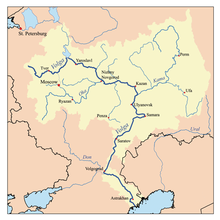
The Tatars, formerly also spelt Tartars, is an umbrella term for different Turkic ethnic groups bearing the name "Tatar" across Eastern Europe and Asia. Initially, the ethnonym Tatar possibly referred to the Tatar confederation. That confederation was eventually incorporated into the Mongol Empire when Genghis Khan unified the various steppe tribes. Historically, the term Tatars was applied to anyone originating from the vast Northern and Central Asian landmass then known as Tartary, a term which was also conflated with the Mongol Empire itself. More recently, however, the term has come to refer more narrowly to related ethnic groups who refer to themselves as Tatars or who speak languages that are commonly referred to as Tatar.

Ivan IV Vasilyevich, commonly known as Ivan the Terrible, was Grand Prince of Moscow and all Russia from 1533, and Tsar of all Russia from 1547 until his death in 1584. He was the first Russian monarch to be crowned as tsar.

The Khanate of Kazan was a medieval Tatar Turkic state that occupied the territory of the former Volga Bulgaria between 1438 and 1552. The khanate covered contemporary Tatarstan, Mari El, Chuvashia, Mordovia, and parts of Udmurtia and Bashkortostan; its capital was the city of Kazan. It was one of the successor states of the Golden Horde, and it came to an end when it was conquered by the Tsardom of Russia.
Safa Giray was three times khan of Kazan. He was the nephew of the previous Kazan Khan Sahib Giray and brother of Moxammat Giray.
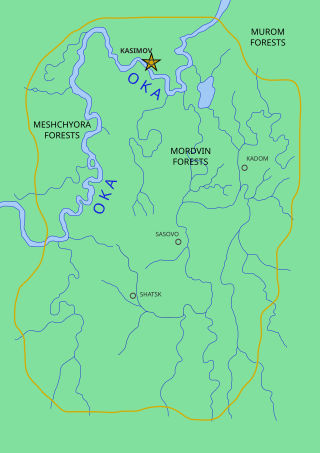
Qasim Khanate or Kingdom of Qasim or Khanate of Qasım was a Tatar-ruled khanate, a vassal of Russia, which existed from 1452 until 1681 in the territory of modern Ryazan Oblast in Russia with its capital at Kasimov, in the middle course of the Oka River. It was established in the lands which Grand Prince Vasily II of Moscow presented in 1452 to the Kazan prince Qasim Khan, son of the first Kazan khan Olug Moxammat.

Ghabdellatif or Abdullatif was the Khan of the Kazan Khanate from 1496 to 1502.
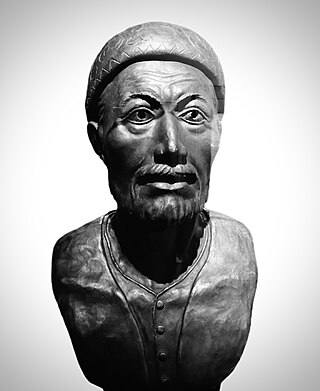
Möxämmät-Ämin xan (Möxämmät Ämin, Möxämmädämin, Russian: Мухаммед-Амин, Muhammed-Amin / Emin, Magmed-Amin, Магмед-Аминь, etc. was three times a pro-Russian khan of Kazan. During his first reign, he actively supported the policies of the Grand Duke of Moscow and proved himself to be "a true friend of Russia". He was also known as a poet; excerpts from his works have survived to this day. After ascending the throne for the second time, he changed his political views, emphasizing the independence of the khans. Muhammed-Amin "enjoyed the love and respect of the people"; Kazan flourished under him. Muhammed-Amin’s remains discovered in Soviet era were buried in the Kazan Kremlin in 2016.
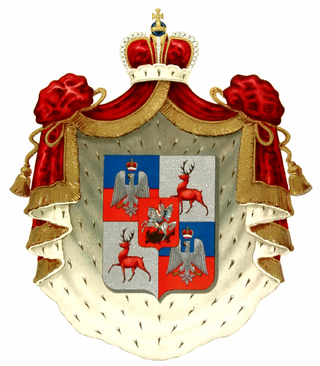
The House of Shuysky was a Rurikid family of Boyars descending from Grand Duke Dimitri Konstantinovich of Vladimir-Suzdal and Prince Andrey Yaroslavich, brother to Alexander Nevsky. The surname is derived from the town of Shuya, of which the Shuiskys gained ownership in 1403. From 1606 to 1610, Vasili Shuisky ruled as tsar over Russia during the Time of Troubles.

Devlet I Giray ruled as Crimean Khan during a long and eventful period marked by significant historical events. These events included the fall of Kazan to Russia in 1552, the fall of the Astrakhan Khanate to Russia in 1556, and the burning of Moscow by the Crimean Tatars in 1571. Another notable event during Devlet's reign was the defeat of the Crimeans near Moscow in 1572. However, Cossack raids into the Crimea were also common during his reign.
Ibrahim khan was the Khan of Kazan from 1467. He was the son of Mäxmüd. He was crowned after Xälil's death and was married to Nur Sultan. In 1467–1469 and 1478, he participated in wars against Muscovy. After concluding a treaty with Ivan III, all Russian prisoners of war held by the Khanate were released. He supported a policy of non-intervention into Muscovy's politics.

The Vorotynsky family was a Russian noble family which was involved in the politics of the Grand Duchy of Moscow and the Tsardom of Russia. Their lands lay principally in the Upper Oka region and comprised the towns of Peremyshl and Vorotynsk as well as parts (дольницы) of Novosil and Odoyev.
The Belsky or Belski family was a Ruthenianized princely family of Gediminid origin in the Grand Duchy of Lithuania. It later defected to the Grand Duchy of Moscow and played a key role during the regency of Ivan IV of Russia. The family started with Ivan Vladimirovich, son of Vladimir Olgerdovich and grandson of Algirdas, and ended with Ivan Dmitrievich Belsky in 1571. The Belsky name was derived from their principal possession of Bely, Tver Oblast.
The Russo-Crimean Wars were fought between the forces of the Tsardom of Russia and the Crimean Khanate during the 16th century over the region around the Volga River.

The Fire of Moscow occurred on 24 May 1571, when the Crimean army led by the khan of Crimea Devlet I Giray, bypassed the Serpukhov defensive fortifications on the Oka River, crossed the Ugra River into the Moscow suburbs, and rounded the flank of the 35,000–40,000 men of the Russian army.
Vasily Danilovich Kholmsky was a Russian knyaz, Boyar and Muscovite voyevoda. He was the son of Prince Daniil Kholmsky and the son-in-law of Grand Prince Ivan III, having married his daughter Feodosiya Ivanovna. Kholmsky was a member of the princely house Kholmsky, and descended from the rulers of the Principality of Tver.
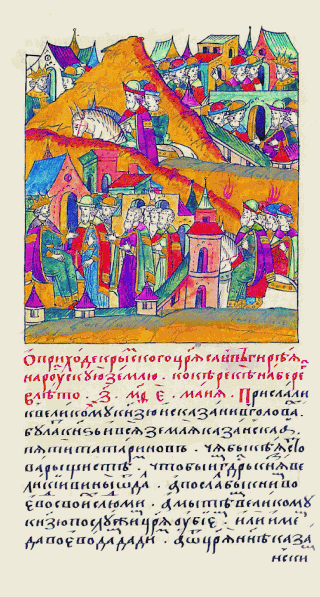
Sahib I Giray (1501–1551) was Khan of Kazan for three years and Khan of Crimea for nineteen years. His father was the Crimean Khan Meñli I Giray. Sahib was placed on the throne of Kazan by his ambitious brother Mehmed of Crimea and driven out of Kazan by the Russians. He became Khan of Crimea with Ottoman support and was expelled by the Turks for disobedience. During his reign Crimean troops fought for the Turks and also fought in the North Caucasus. In 1532-1584, during the long reigns of Sahib I Giray, Devlet I Giray and Mehmed II Giray, Crimea was at the height of its power.

Daniil Dmitrievich Kholmsky was a Russian knyaz (князь), boyar and voyevoda (воевода), and one of the most prominent military leaders of Ivan the Great. He belonged to the princely house Kholmsky and was the father of another voyevoda and boyar, Vasily Danilovich Kholmsky, who later married the second daughter of Ivan the Great, Feodosiya Ivanovna.

The Muscovite War of Succession, or Muscovite Civil War, was a war of succession in the Grand Duchy of Moscow (Muscovy) from 1425 to 1453. The two warring parties were Vasily II, the son of the previous Grand Prince of Moscow Vasily I, and on the other hand his uncle, Yury Dmitrievich, the Prince of Zvenigorod, and the sons of Yuri Dmitrievich, Vasily Kosoy and Dmitry Shemyaka. In the intermediate stage, the party of Yury conquered Moscow, but in the end, Vasily II regained his crown.

Vyatka Land is a historical region in the basin of the Vyatka River, approximately corresponding to modern-day Kirov Oblast in Russia. While the Permians were its original inhabitants, it was gradually settled by Slavic settlers whose arrival is traditionally dated to the late 12th century. Vyatka Land, being geographically isolated from the rest of the Russian lands, sometimes accepted the suzerainty of other Russian and Tatar states but de facto enjoyed a large degree of independence until it was annexed by the Grand Duchy of Moscow in 1489.

